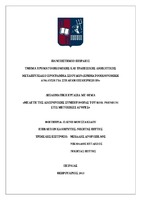Μελέτη της διαχρονικής συμπεριφοράς του risk premium στις μετοχικές αγορές

View/
Subject
Ασφάλιση ; Ασφάλιστρα ; Μετοχικές αποδόσειςKeywords
Ασφάλιστρο κινδύνου μετοχώνAbstract
This paper deals with the risk premium that is the performance of the various assets to the performance without risk which empirically investigates the behavior relative to the risk free rate. The various assets do not offer firm revenues in the future. On the other hand, they involve some level of risk to the investor who seeks a higher yield in order to be rewarded for the risk taken apart from the present consumption. How much higher this performance is depends on the level of risk perceived by the investor, who expresses their dislike differently asking for different levels of risk premium.
The separation of the concepts of risk premium in required, historical, expected, and implicit, as well as the importance of evaluating investment decisions and portfolio level fixed investment level follow. A set of empirical calculating methods is given and reference is made to the paradox of the shares risk premium (equity risk premium puzzle), the Capital Asset Pricing Model and the Arbitrage Pricing Theory, all related to the calculation of the required risk premium. The main elements relating to the efficient markets hypothesis, which is consistent with the valuation models, are presented.
The investigation focuses on whether the historical risk premium depends on the risk free rate and how the risk premium behaves in periods of sharply changing interest rates. The research sample consists of historical markers in various sectors of the stock market of the USA during the period 2005 - 2014. The main findings include that the historical risk premium is negative relationship without asymmetries with the rates for all sectors.


